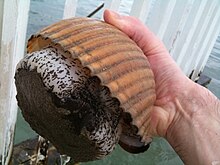Tonna galea
| Giant tun | |
|---|---|
 |
|
| Five views of a shell of Tonna galea | |
 |
|
| A live giant tun, from Greece | |
| Scientific classification | |
| Kingdom: | Animalia |
| Phylum: | Mollusca |
| Class: | Gastropoda |
| (unranked): | clade Caenogastropoda clade Hypsogastropoda clade Littorinimorpha |
| Superfamily: | Tonnoidea |
| Family: | Tonnidae |
| Genus: | Tonna |
| Species: | T. galea |
| Binomial name | |
|
Tonna galea (Linnaeus, 1758) |
|
| Synonyms | |
|
See List of synonyms |
|
See List of synonyms
Tonna galea, commonly known as the giant tun, is a species of marine gastropod mollusc in the family Tonnidae (also known as the tun shells). This very large sea snail or tun snail is found in the North Atlantic Ocean as far as the coast of West Africa, in the Mediterranean Sea and the Caribbean Sea. The species was first described by Carl Linnaeus in 1758.
The ventricose shell of adult Tonna galea is very large, with an average height of 6 inches (150 mm). Specimens of this species have been quoted of the size of a man's head. The shell is thin and inflated, but still relatively solid and durable. The shell is almost diaphanous when young; at that time the transverse ribs of the surface are only indicated by lines of a slightly deeper tint. In terms of its weight however, the thin shell is very much lighter than the shell of most other large sea snails. The aperture of the shell is "distinctly round" and wide.
The conical spire is formed of six convex, very distinct whorls, loaded externally with wide, flat, slightly raised ribs, separated by narrow and superficial furrows. The whorls of the spire are isolated by a deep channeled suture. The body whorl is rounded and very ventricose. The aperture is large, subovate, colored interiorly with reddish, and marked with transverse ribs corresponding to the furrows without. The outer lip is dilated, undulated, tinged with black, or a deep brown upon the edge. The inner lip is whitish, spread out in a very thin plate upon the belly of the body whorl. The columella is smooth, polished, and forms at the left of the umbilicus a thick rib, marked by transverse striae, which terminates at the emargination of the base. The external surface of this shell is of an uniform reddish fawn color ; nevertheless the ribs are varied with wide spots or irregular brown and white blotches which are very remarkable.
...
Wikipedia
